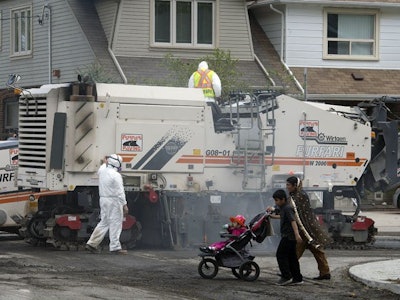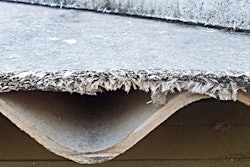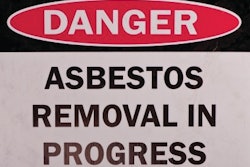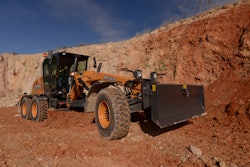
Asphalt today is relatively safe to work with. Crews don’t have to worry about their health, or the health of the public, on a typical milling and paving job. However, back in the 1960’s it wasn’t unusual for asphalt to contain asbestos. These minerals were used to help reinforce paving materials and slow deterioration from road salt, according to the Mesothelioma Cancer Alliance. However, prolonged inhalation of asbestos fibers can cause serious and fatal illnesses including lung cancer and mesothelioma.
So today, over 50 years later, crews are taking precautions whenever they encounter these type of roads. Not only can this type of job be dangerous, it’s also regulation intensive, and more expensive than a typical job.
Still, there is a need for this type of work as it's estimated nearly 55 total miles of roads in Pennsylvania contain these asbestos fibers. Dealing with asphalt that contains asbestos “is not common, but it’s not rare either,” says Michael Crochunis, Pennsylvania Department of Transportation (PennDot) spokesman. “That was the norm for when these roads were placed and we’re still dealing with that.”
[Better safe than sorry]
“Asbestos fibers were evaluated as experimental construction projects in at least three different PennDOT research projects initiated in 1962, 1966, and 1970,” says Timothy L. Ramirez, P.E. at PennDOT. “These experimental projects evaluated asbestos fibers in different pavement course types/sizes. These experimental research projects documented the projects and project locations. Additional non-experimental projects were constructed and noted by specific nomenclature typically including "Bituminous Wearing Course FJ-4A" in the paving course’s or mixture’s nomenclature designating it as containing Asbestos fibers.”
If necessary to confirm or verify the existence or limits of the asbestos fiber containing asphalt pavement, pavement core samples are collected, the asphalt is extracted from the aggregate and fibers, and the presence of fibers is visually confirmed. Further analysis of the fibers could be done to verify they are asbestos through Polarized Light Microscopy (PLM).
PennDOT’s pavement history records may indicate this nomenclature and can be used to determine locations of previous projects or asphalt paving mixtures containing asbestos fibers. Testing would only be done to verify the experimental pavement course or “FJ-4A” type course still exists or to verify the limits of the previous experimental projects or previous “FJ-4A” type projects.
The concentrations found on one project, New Holland Avenue, were small, ranging from 1% to 3%, and 19 of 24 core samples taken from the road showed no asbestos at all. "We still want to use proper precautions," Crochunis says.
[Working at will]
Contractors who wish to bid on a job like this, at least in Pennsylvania, must complete the "Asbestos Abatement and Demolition/Renovation Form." The form must be submitted at least 20 working days prior to the initiation of asbestos abatement/renovation work. Once the draft is approved, must be submitted to both the Pennsylvania Department of Environmental Protection (PA DEP) and the United States Environmental Protection Agency (U.S. EPA) at least ten working days prior to the initiation of asbestos abatement/ renovation work.
Along with other forms and notifications, the contractor complete the "Property Owner Notification" and deliver to all adjacent properties within the project limits one week prior to the initiation of asbestos abatement/renovation work.
The fliers direct residents to “minimize their outdoor activities, keep windows and doors shut, and consider turning off HVAC systems that draw in outside air during the removal of the asphalt material when work operations are occurring immediately adjacent to their property.
The traffic flow is also changed. “Normally, we’d only close one lane and have flaggers directing traffic,” says Crochunis. “But because we will have workers wearing HazMat (hazardous materials) suits because of the asbestos, we didn’t want to have people driving through with their windows down.”
[Proceed with caution]
Asbestos is tightly bound in the asphalt, and does not become airborne under normal roadway use. However, tearing up a roadway, involves drilling, cutting, excavation and milling, all of which can generate clouds of dust.
During the removal phase, all workers who will be working on or near any activity that will potentially render the asbestos-containing bituminous pavement friable (including but not limited to saw cutting, jackhammering, milling, drilling, and excavating) must have, at a minimum, eight hours of Pennsylvania Department of Labor and Industry-approved asbestos awareness training.
Training of these workers consists of informing workers of the health effects associated with asbestos exposure, the relationship between smoking and asbestos exposure, appropriate work practices and engineering controls for minimizing asbestos fiber releases, "hands-on" training, and the proper selection and use of personal protective equipment.
Asbestos warning signs are to be posted during the disturbance of asbestos-containing bituminous pavement in and around the construction and field office trailers.
Since the generation of visible dust emissions during activities disturbing asphalt-containing bituminous pavement is prohibited, the contractor must use a wet-milling method when removing the existing pavement.
On the New Holland Avenue project, a Wirtgen W210 Milling Machine was used along with a wetting agent as added to the water system in the milling machine.
“The wetting agent consolidates the water molecules making the ‘water wetter,’” Crochunis says. “The water system has spray nozzles which spray the head of the miller to eliminate dust, soaking the material to be loaded by the conveyor into the trucks.”
Wet sweeping was also done with mechanical brooms. The material was swept when it was still wet and loaded into trucks lined with plastic. The roadway was then sprayed with trackless tack to encapsulate the remaining dust.
Air monitoring and analysis is required during these removal operations to ensure procedures are adequate to comply with State and Federal air quality regulations when abating/removing asbestos containing materials.
The asbestos precautions make the milling more expensive than normal, Crochunis said: about $14 per square foot, versus $3.80 per square foot.
For the New Holland Avenue segment, that raises the cost of the milling phase from about $63,450 to about $233,800, he said.
[Not “green” friendly]
Obviously this material is not a candidate for being re-used on future projects. PennDot says the asbestos-containing asphalt is considered residual waste and contractors cannot reuse any excavated or milled asbestos-containing bituminous material. They must secure an approved and permitted disposal facility for asbestos-containing bituminous pavement prior to the initiation of work.
Material must be transported to the disposal facility while still wet and in tarped trucks with appropriate placards. Drivers must provide documentation to verify the proper transportation and disposal of the removed pavement to the engineer.
In this case, the materials were transported to the LCSWMA Frey Farm Landfill with proper manifest documentation. Disposal is in a Commonwealth of Pennsylvania, Department of Environmental Protection approved and permitted disposal facility for asbestos-containing asphalt pavement.



















